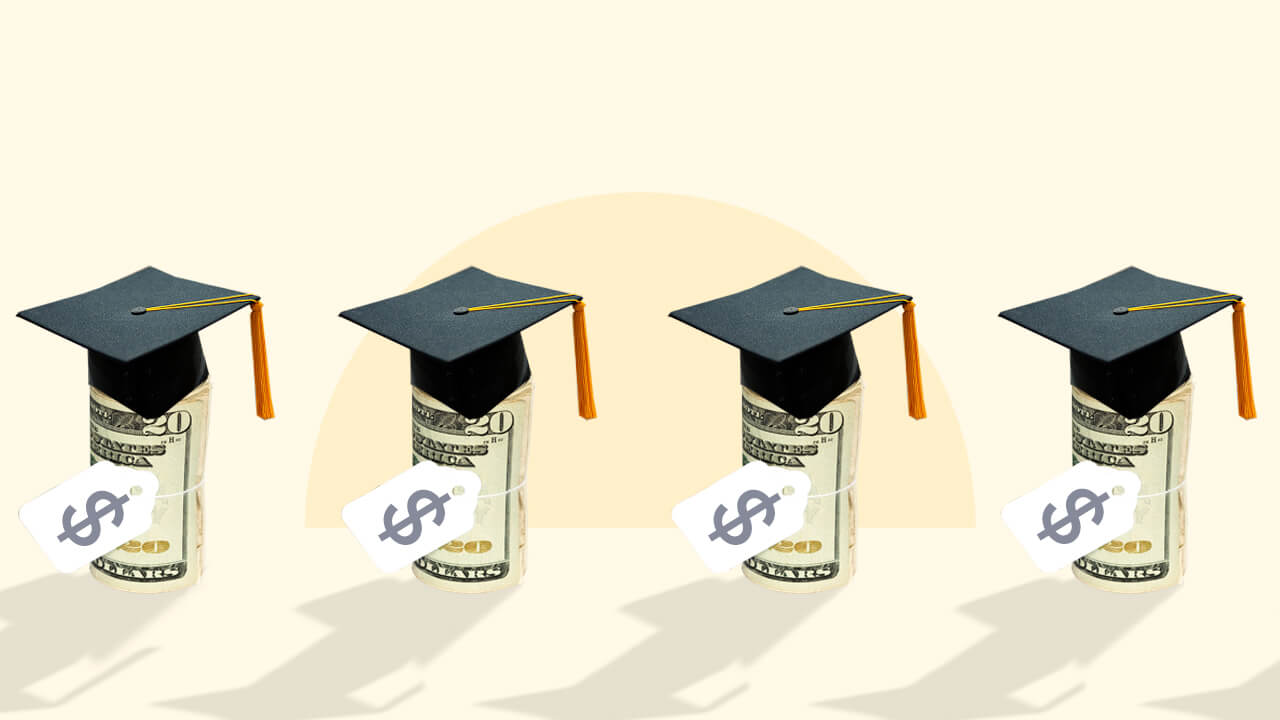Key takeaways
- There are two main types of student loans: federal and private.
- Federal student loans are easier to qualify for and have more flexible repayment options than private loans, including possible paths to loan forgiveness.
- Private student loans may offer lower interest rates with higher loan limits for borrowers with excellent credit.
- Most advisors suggest borrowing the maximum federal loan amount available and using private loans to supplement if needed.
The two types of student loans are federal and private. Federal student loans are managed by the federal government, and the rates and terms are the same regardless of your credit score.
Private student loans are offered by financial institutions, and rates vary depending on your credit score and income. Private student loan rates can be significantly lower than federal loan rates for excellent credit borrowers. But they have fewer repayment options and borrower protections, and rates can be high for borrowers with bad credit.
Understanding how each type of student loan works, who it benefits and how it’s repaid can help you determine which is best for your higher education expenses.
Student loan types: Federal and private
There are several different financing options to choose from within the federal and private student loan categories. For federal loans, keep an eye on the repayment terms and loan limit adjustments each year you’re in school. The rates are set annually by Congress and are the same regardless of your credit.
Private student loans offer a broader range of APRs and loan amounts with stricter qualifying requirements.
| Direct Subsidized Loan | Direct Unsubsidized Loan | Direct PLUS Loan | Private student loan | |
| Type | Federal | Federal | Federal | Private |
| Interest rate | 6.53% (2024-25) | 6.53% for undergraduates, 8.08% for graduates (2024-25) | 9.08% (2024-25) | Around 3.5% to 16% |
| Repayment term | Standard 10-year term | Standard 10-year term | Standard 10-year term | 5 to 25 years |
| Eligible borrowers | Undergraduates with financial need; borrower must be a U.S. citizen or permanent resident and meet other eligibility criteria | Undergraduates and graduates; borrower must be a U.S. citizen or permanent resident and meet other eligibility criteria | Graduates and parents; borrower must be a U.S. citizen or permanent resident and meet other eligibility criteria | Undergraduates, graduates and parents; borrowers must have good credit and a steady income |
| Best for | Undergraduate borrowers from low-income families | Borrowers who don’t qualify for need-based aid | Graduate students who have maxed out unsubsidized loans; parents | Borrowers who have maxed out federal loans; borrowers with excellent credit |
| Maximum loan limits |
Dependent undergraduate: $31,000 (lifetime) Independent undergraduate: $57,500 (lifetime) |
$20,500 annually $138,500 lifetime max |
Up to the cost of attendance minus any other financial aid received |
Up to the cost of attendance if qualified based on creditworthiness Some lenders have annual and total limits |
Types of federal student loans
Most students apply for federal student loans over private loans because they’re the easiest to get approved for. They also offer flexible repayment options with built-in hardship protection that most private loan programs can’t match.
Rates are the same regardless of your credit history, but every federal loan requires an origination fee. You won’t find any refinance options with federal loans, although they can be consolidated for a slight increase in your rate.
The federal Direct Loan Program offers a few loan types.
How to get federal student loans
You must complete the Free Application for Federal Student Aid (FAFSA) application to determine how much federal aid you’re eligible to receive, including federal student loans.
Direct subsidized loans
Direct subsidized loans are available to undergraduate students who have demonstrated financial need. These loans do not accrue interest while the borrower is in school, during the six-month grace period or through any deferment period afterward. After filling out the FAFSA, students will receive a financial aid offer letter.
Direct unsubsidized loans
Direct unsubsidized loans are available to undergraduate, graduate and professional students. Borrowers don’t need to demonstrate financial need and can borrow significantly more than a subsidized loan.
The key difference is that these loans accrue interest immediately. This means that you’ll be charged interest on the balance you owe while you’re in school, after graduation and during periods of deferment and forbearance. This finance option also requires that you fill out the FAFSA.
Direct PLUS loans
Direct PLUS Loans are available to the parents of dependent undergraduate, graduate or professional students to help pay for education expenses. Unlike other federal student loans, parent PLUS loans are taken out by parents directly.
Students can make payments themselves, but their parents will still be legally and financially responsible for repaying the full balance of parent PLUS loans. Students hoping to build a credit score by making payments are out of luck; the loan will show up on only the parents’ credit report, not the student’s.
Direct PLUS Loans (also known as graduate PLUS loans and parent PLUS loans) feature higher interest rates and loan origination fees than Direct Subsidized and Unsubsidized Loans.
All federal loans — including PLUS loans that were taken out for a student — are discharged if the borrower or student dies. This is not something private loans always offer.
Types of private student loans
Federal student loans offer only fixed rates, while private student loans can have fixed or variable interest rates. Qualified borrowers may get rates well below those provided by federal loans. Loan amount ranges are typically higher than federal loans, and many lenders offer no-fee options, which could add up to significant savings over your educational career.
There are several types of private student loans, including undergraduate, graduate and parent loans. It’s important to check the death discharge requirements — some private loan lenders have the right to pursue your estate if you pass away with a balance due.
Undergraduate loans
Undergraduate private student loans often come with a wider range of repayment terms and maximum loan amounts. Rather than setting a borrowing cap, some lenders offer loans as large as the full cost of attendance. Private lenders may also offer perks like discounts on your principal upon graduation or for academic performance.
However, unlike federal student loans, you’ll have to qualify for the loan based on a review of your credit and income. Private loans almost always require a cosigner since undergraduates have typically not had time to develop a credit history.
If private student loan rates drop after you’ve left school, many lenders offer refinance options that could save you money if you qualify.
Graduate loans
Private student loan lenders may offer specific loan options tailored to graduate, law, medical and business school students. These loans are less likely to require a cosigner than undergraduate loans.
In many cases, private graduate student loans also come with benefits specific to a graduate school student’s needs. That may include long grace periods, in-school deferment periods and additional deferment while students complete a residency.
Private student loans for parents
If you have good credit and a stable income, a private loan may offer better terms to help you pay for your child’s education than a Parent PLUS loan. Like other private student loans, interest rates can be fixed or variable. You’re also unlikely to pay an origination fee.
However, repayment may begin right away. While many federal (and even private) loan options come with an in-school deferral period, private parent loans are more likely to require immediate monthly repayments.
Which type of student loan should you choose?
There are no hard-and-fast rules for deciding which loan option is best for you. Most financial aid advisors suggest prioritizing federal student loans first because they’re the easiest to qualify for and offer more flexible repayment options.
But private student loans may be worth a look if your federal aid amount isn’t enough to cover the full cost of attendance. Make sure you understand when and how you’ll start repaying to avoid a shock to your budget or the potential for defaulting.
Federal student loans
Best for: Students with no income or credit history, or those who want the extra security of federal protections
Federal student loans are suitable for every kind of qualifying borrower. They offer unique repayment options, including income-driven repayment, and longer deferment periods than private lenders. Plus, they’re the only avenue for loan forgiveness programs.
They also don’t have a minimum credit score requirement, so undergraduates can access loan funds without needing a cosigner. In general, borrowers should max out their federal student loans before taking out private loans.
Private student loans
Best for: Students with superb credit, a stable job or a creditworthy cosigner
Private student loans are best for excellent credit borrowers. They also come in handy for students who don’t qualify for federal student loans due to citizenship status or who need to borrow more than what federal student loans provide.
Be sure to compare the hardship and repayment options before you take out a private loan. Private loan lenders don’t offer the same protections that federal loans do.
What to look for in a student loan
Whether you’re borrowing a federal or private loan, be sure to read the fine print and understand your repayment obligations before borrowing. If you’re weighing several options, consider the following criteria:
- Repayment options: Whether you want to make full or interest-only payments in school or defer all payments until after graduation, make sure your lender offers the option you want. Some also allow you to choose different term lengths so you can tailor your payment to your budget.
- Cosigner release options: If you need a cosigner (either because the lender requires it or because of your credit rating), determine whether it offers cosigner release. A release lets you remove your cosigner from the loan after you’ve made a specific number of on-time payments. The minimum payment period could be as little as six months or as long as four years — if the lender offers a release option at all.
- Discounts: Many lenders offer a small APR discount if you sign up for automatic payments. Others may offer rate discounts for borrowers who have another financial product with them, cash rewards for referrals or a principal reduction at graduation.
- Fees: Origination fees can add up, especially if you borrow tens of thousands of dollars over several years. If you qualify for private student loans, you can generally avoid paying this fee, but it’s unavoidable with federal student loans.
- Hardship programs: Unlike federal student loans, not all private loans come with the option to pause or postpone payments if you have a financial setback. Federal hardship programs can be a major relief after a job loss, unexpected drop in income or other financial challenge.
- Lender reviews: Reviews may alert you to any issues with the lender, like difficulties processing payments or slow service representative communication. You can see what other students think of different lenders by checking out their Better Business Bureau rating or reading in-depth reviews on our student loan review page.
Bottom line
Every student should complete the FAFSA, even if you don’t expect to qualify or think you’ll need to borrow. This can help you develop the rest of your game plan for borrowing money from other sources.
If private student loans are needed, compare several lenders by visiting their websites. You can also take a look at best student loan rates on a marketplace site like Bankrate before applying to get a student loan.
Read the full article here





